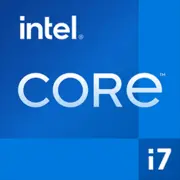Intel Core i7-12650HX

Intel Core i7-12650HX: Mobile Power for Professionals and Gamers
March 2025
The Intel Core 12th generation processors, including the i7-12650HX model, represent a significant step in the evolution of mobile CPUs. Despite the launch of newer generations (such as Meteor Lake and Lunar Lake), this model remains popular in the high-performance laptop segment due to its balance of performance and price. Let's explore who the i7-12650HX is suitable for in 2025 and what tasks it can handle.
1. Architecture and Process Technology: Hybrid Alder Lake Approach
The i7-12650HX processor is built on the hybrid architecture of Alder Lake (Intel 7 process, formerly known as 10nm Enhanced SuperFin). This is Intel's first design combining Performance-cores (P-cores) and Efficient-cores (E-cores).
- Cores and Threads: 14 cores (6 P-cores + 8 E-cores) and 20 threads. P-cores operate at a base frequency of 2.3 GHz with turbo boost up to 4.7 GHz, while E-cores reach up to 3.4 GHz.
- Cache: 24 MB L3 — sufficient for handling complex tasks (e.g., rendering 3D scenes).
- Integrated Graphics: Intel UHD Graphics for 12th generation (96 EU, 1.45 GHz). It is suitable for basic tasks (office work, 4K video), but for gaming or video editing, a discrete graphics card is required.
Architecture Features:
- Thread Director — an algorithm that distributes tasks between P-cores and E-cores. For example, games or Photoshop automatically run on P-cores, while background processes run on E-cores.
- Support for DDR5-4800 and PCIe 5.0 — relevant for high-speed NVMe storage and future graphics cards.
2. TDP 55W: A Balance Between Power and Heat
The nominal TDP of the processor is 55W, but in turbo mode, power consumption can reach 157W. This requires an efficient cooling system.
- In compact laptops (e.g., 15-inch ultrabooks), the i7-12650HX often operates at reduced frequencies to avoid overheating.
- In gaming models (MSI GP76, ASUS ROG Strix) with robust coolers, the processor unleashes its potential, maintaining high frequencies under load.
Power-saving Technologies:
- Intel Dynamic Tuning 2.0 — adaptively adjusts power consumption based on workload.
- Speed Shift — instant switching between processor states to save battery life.
3. Performance: From Office Work to 4K Rendering
Office and Multimedia
- PCMark 10 Test: 6500 points. A laptop with the i7-12650HX easily handles 50+ tabs in Chrome, streaming video, and document editing.
- Adobe Photoshop: Processing RAW files (50 MP) takes 1.5–2 seconds per operation.
Gaming
With a discrete graphics card (e.g., NVIDIA RTX 4060 or AMD RX 7600M XT):
- Cyberpunk 2077 (1440p, Ultra): 60–65 FPS with DLSS.
- Fortnite (1080p, Epic): 120–140 FPS.
Turbo Mode:
In the Cinebench R23 benchmark, the processor scores 14500 points (multi-threaded mode), but after 5 minutes, the frequency of P-cores drops to 4.1 GHz due to heating. A quality cooler is crucial for stable performance in professional applications.
4. Use Cases: Who is the i7-12650HX Suitable For?
- Gamers: paired with an RTX 4070 or higher — for QHD gaming.
- Creative Professionals: video editing in DaVinci Resolve, 3D modeling in Blender.
- Engineers: code compilation, CAD projects (SolidWorks, AutoCAD).
Not suitable for:
- Users who prioritize battery life (more than 8 hours).
- Those who only work with web applications and office tasks — an i5 or Ryzen 5 would suffice.
5. Battery Life: A Trade-off for Performance
With active usage (gaming, rendering), a laptop with the i7-12650HX lasts 2–3 hours on battery. In power-saving mode (50% brightness, office tasks) — up to 6 hours.
How to Extend Battery Life:
- Activate the "Battery Saver" mode in Windows.
- Disable turbo mode through utilities like ThrottleStop.
- Choose models with a battery of at least 90 Wh.
6. Comparison with Competitors
- AMD Ryzen 7 7840HS (Zen 4, 8 cores/16 threads): better in multi-threaded tasks (e.g., rendering), but weaker in single-threaded (gaming).
- Apple M3 Pro (12 cores): 30% more energy-efficient, but limited compatibility with Windows applications.
- Intel Core i7-13700H (Raptor Lake): 10–15% faster in games but more expensive.
Prices: Laptops with the i7-12650HX in 2025 range from $1100–$1600 (e.g., Lenovo Legion Pro 5 — $1300, Acer Predator Helios 300 — $1500).
7. Pros and Cons
Strengths:
- High performance in gaming and professional applications.
- Support for DDR5 and PCIe 5.0.
- Optimization for Windows 11.
Weaknesses:
- Heating under load.
- Short battery life.
- Integrated graphics are weaker than AMD Radeon 780M.
8. Recommendations for Choosing a Laptop
- Gaming Models: At least 16 GB DDR5, 1 TB SSD, RTX 4060/4070. Example: MSI Katana 15 (from $1200).
- Workstations: Display with accurate color reproduction (100% sRGB), Thunderbolt 4 ports. Example: Dell Precision 5570 (from $1800).
- Versatile Laptops: 16:10 display, weight up to 2 kg. Example: ASUS Vivobook Pro 16X (from $1400).
What to Pay Attention To:
- The number of fans (better to have two or three).
- Upgradeability of RAM and SSD.
9. Final Conclusion
The Intel Core i7-12650HX in 2025 is an excellent choice for those needing a mobile workstation or gaming laptop without overpaying for top-of-the-line models. Its key advantages include:
- Power for gaming and professional tasks.
- Compatibility with new memory and storage standards.
However, be prepared for compromises: short battery life and noisy coolers. If silence and long battery life are important to you, consider the AMD Ryzen 7 7840U or the Apple MacBook Pro with M3.
Basic
CPU Specifications
Memory Specifications
GPU Specifications
Miscellaneous
Share in social media
Or Link To Us
<a href="https://cputronic.com/cpu/intel-core-i7-12650hx" target="_blank">Intel Core i7-12650HX</a>